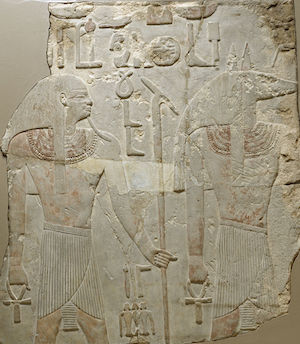
In Ancient Egypt Geb (also known as Seb, Keb, Kebb or Gebb) was a god of the earth and one of the Ennead of Heliopolis. His grandfather was Atum (the self-created creator god), his father was Shu (the god of air) and his mother was Tefnut (the goddess of moisture). Osiris, Isis, Seth and Nephthys were the children of Geb and his sister-wife Nut (the goddess of the sky). Geb was the third divine pharaoh, reigning after his father, Shu, and before Osiris. He also supported Horus’ right to the throne following the death of Osiris. As the Egyptians believed that the pharaoh was the living image of Horus, the pharaoh was sometimes known as the “Heir of Geb”.
In the book of the dead, the Pharaoh says “I am decreed to be the Heir, the Lord of the Earth of Geb. I have union with women. Geb hath refreshed me, and he hath caused me to ascend his throne.”
One ceremony to mark the accession of a new pharaoh involved the release of four wild geese, to the four corners of the sky, to bring luck to the new king. During the Ptolemaic period, Geb became identified with the Greek god Kronos (time).
It is thought that his worship originated around Iunu (Heliopolis) during the pre-dynastic period but may postdate the worship of Aker (another earth god). It seems that Geb was largely worshiped as a goose, his sacred animal, during the pre-dynastic period. Edfu (Apollinopolis Magna) was called the “Aat of Geb,” and Dendera was also known as “the home of the children of Geb”. It may seem strange to have a male earth god (most cultures associating the earth with female power) but Geb was sometimes considered to be bisexual. In his shrine in Bata in Iunu he laid the great Egg (symbolising rebirth and renewal) from which the Sun-god arose in the form of a phoenix or Benben. He was given the epithet “The great Cackler” because of the noise he made when the egg was laid.

He was also called the “Rpt” (the hereditary, tribal chief of the gods), and the earth itself was referred to as “pr-gb-b” (“The House of Geb”). Earthquakes were thought to be his laughter and it was he who supplied the minerals and precious stones found in the earth, as a god of mines and caves. The sign used in his name became associated with vegetation and the lush farming land by the Nile. It was said that barley grew on his ribs and he was depicted with green patches of vegetation all over his body. As a god of the harvest, he was sometimes considered to be the spouse of Renenutet, the cobra goddess.
Geb had authority over the tombs buried in the earth, and assisted in the ritual of weighing the heart of the deceased in the Halls of Ma’at. The justified dead were given words of power which allowed them to ascend to the sky, while those whose hearts were weighed down with guilt were trapped in the earth by Geb.
Thus, he could be a malevolent being as well as a beneficial deity, imprisoning the dead in his body. His wife Nut was often depicted on the cover of a sarcophagus, while Geb was represented by the base indicating that the justified dead were protected by both deities.

According to another creation myth, Geb and Nut angered the sun god Ra, their grandfather, because they were locked in a perpetual embrace. On the orders of Ra, they were separated by Shu who stood on Geb and lifted Nut high up above him – creating our atmosphere by separating the sky from the earth. However, Nut was found to be pregnant and gave birth to Osiris, Horus the Elder, Set, Isis, and Nephthys. Geb still longed for his sister, and was often depicted lying prone with his erect phallus pointing towards her body. He wept when he was separated from her, and so created the oceans of the world.
It seems that his lust did not stop there. The Phakussa Stele (Ptolemaic period) tells of Geb’s infatuation with his mother, Tefnut. His father Shu fought with the followers of the serpent Apep, and was weakened by this battle. Shu ascended to the heavens to recuperate. When Shu was gone, Geb sought out his mother and raped her. Nine days of darkness and storms followed and then Geb went to take his father’s place as Pharaoh.

When he reached out to the cobra (ureas) on the crown of Re, it read his guilt, killed all of his companions, and severely wounded him. It was only by the application of a lock of Ra’s hair that Geb was saved. Despite his heinous crime, Geb went on to be a good king who protected the land and its people.
Geb was usually depicted as a man wearing a combination of the white crown and the Atef crown, although he was also depicted as a goose – his sacred animal. When he takes the form of a man he is generally prone (as a personification of the earth) and sometimes coloured green with vegetation growing from his body. As the Earth, he is often seen lying beneath the sky goddess Nut, leaning on one elbow, with one knee bent toward the sky, (echoing the shape of two mountains and a valley).
Bibliography
- Bard, Kathryn (2008) An introduction to the Archaeology of Ancient Egypt
- Goodenough, Simon (1997) Egyptian Mythology
- Pinch, Geraldine (2002) Handbook Egyptian Mythology
- Redford, Donald B (2002) Ancient Gods Speak
- Wilkinson, Richard H. (2003) The Complete Gods and Goddesses of Ancient Egypt
- Wilkinson, Richard H. (2000) The Complete Temples of Ancient Egypt
Copyright J Hill 2010